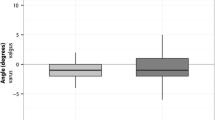Abstract
Purpose
Whether minimally invasive total knee arthroplasty (MIS-TKA) could offer better and faster recovery without the deviation of post-operative prosthesis position and limb alignment is still controversial. This prospective and randomized study was conducted to compare the clinical and radiological outcomes between patients who underwent the mini-subvastus approach of MIS-TKA and those who underwent the medial parapatellar approach of traditional TKA.
Methods
Fifty patients, including 50 knees, who required TKA due to osteoarthritis were randomized to the mini-subvastus group (group I) or the medial parapatellar group (group II). All patients accepted the same method of anaesthesia, equal support therapy and identical rehabilitation exercise after surgery. The evaluation system included operation time, tourniquet time, blood loss, skin incision length in flexion, straight leg raising time, the time of lower limb muscle strength up to grade 4, the time of walking with aid or without aid, the time of walking up and down the stairs, the active flexion angle, range of movement (ROM), the Knee Society Scores (KSS), visual analogue score for pain (VAS), hospital stays and radiographic outcomes.
Results
The mini-subvastus approach offered smaller skin incision length in flexion, but at the cost of operation time (P < 0.001). No significant difference was found in tourniquet time and blood loss. The patients in group I could achieve straight leg raising, the lower limb muscle strength up to grade 4, walking with or without aid, and walking up and down the stairs earlier (P < 0.001). The active flexion angle, ROM, VAS and KSS in group I were superior to those in group II until six months post-operatively (P < 0.001), but the differences was not apparent at 12 months post-operatively. More importantly, there was no significant difference between the two groups on radiological outcomes (P > 0.05).
Conclusions
The mini-subvastus approach could offer faster recovery, less pain and shorter hospital stays without compromising the principles of proper prosthesis position and limb alignment compared with the medial parapatellar approach.





Similar content being viewed by others
References
Heekin RD, Fokin AA (2014) Mini-midvastus versus mini-medial parapatellar approach for minimally invasive total knee arthroplasty. J Arthroplast 29(2):339–342
Kohrt W, Shulman B, Muratore T, Bade M, Dayton M, Stevens-Lapsley J (2012) Minimally invasive total knee arthroplasty: surgical implications for recovery. J Knee Surg 26(03):195–202
Lin SY, Chen CH, Fu YC, Huang PJ, Lu CC, Su JY, Chang JK, Huang HT (2013) Comparison of the clinical and radiological outcomes of three minimally invasive techniques for total knee replacement at two years. Bone Joint J 95-B(7):906
Pan WM, Li XT, Qian ZL, Zhang Q, Zhang CM (2010) Mini-subvastus versus a standard approach in total knee arthroplasty: a prospective, randomized, controlled study. J Int Med Res 38(3):890–900
Lai Z, Shi S, Fei J, Wei W (2014) RETRACTED ARTICLE: Total knee arthroplasty performed with either a mini-subvastus or a standard approach: a prospective randomized controlled study with a minimum follow-up of 2 years. Arch Orthop Trauma Surg 134(8):1155–1162
Lin W-P, Lin J, Horng L-C, Chang S-M, Jiang C-C (2009) Quadriceps-sparing, minimal-incision total knee arthroplasty. J Arthroplast 24(7):1024–1032
Thiengwittayaporn S, Fusakul Y, Kangkano N, Jarupongprapa C, Charoenphandhu N (2015) Hand-held navigation may improve accuracy in minimally invasive total knee arthroplasty: a prospective randomized controlled trial. Int Orthop 40(1):51–57
Schroer WC, Diesfeld PJ, Reedy ME, LeMarr AR (2008) Mini-subvastus approach for total knee arthroplasty. J Arthroplast 23(1):19–25
Thiengwittayaporn S, Kanjanapiboonwong A, Junsee D (2013) Midterm outcomes of electromagnetic computer-assisted navigation in minimally invasive total knee arthroplasty. J Orthop Surg Res 8(1):37
Young SW, Mutu-Grigg J, Frampton CM, Cullen J (2014) Does speed matter? Revision rates and functional outcomes in TKA in relation to duration of surgery. J Arthroplast 29(7):1473–1477.e1471
Cho K-Y, Kim K-I, Umrani S, Kim S-H (2013) Better quadriceps recovery after minimally invasive total knee arthroplasty. Knee Surg Sports Traumatol Arthrosc 22(8):1759–1764
Tsuji S, Tomita T, Fujii M, Laskin RS, Yoshikawa H, Sugamoto K (2010) Is minimally invasive surgery–total knee arthroplasty truly less invasive than standard total knee arthroplasty? J Arthroplast 25(6):970–976
Yang G, Huang W, Xie W, Liu Z, Zheng M, Hu Y, Tian J (2015) Patellar non-eversion in primary TKA reduces the complication rate. Knee Surg Sports Traumatol Arthrosc 24(3):921–930
Chiang H, Lee C-C, Lin W-P, Jiang C-C (2012) Comparison of quadriceps-sparing minimally invasive and medial parapatellar total knee arthroplasty: a 2-year follow-up study. J Formos Med Assoc 111(12):698–704
Tasker A, Hassaballa M, Murray J, Lancaster S, Artz N, Harries W, Porteous A (2014) Minimally invasive total knee arthroplasty; a pragmatic randomised controlled trial reporting outcomes up to 2 year follow up. Knee 21(1):189–193
Kashyap SN, van Ommeren JW (2008) Clinical experience with less invasive surgery techniques in total knee arthroplasty: a comparative study. Knee Surg Sports Traumatol Arthrosc 16(6):544–548
Schroer WC, Diesfeld PJ, Reedy ME, Lemarr AR (2007) Evaluation of complications associated with six hundred mini-subvastus total knee arthroplasties. J Bone Joint Surg Am Vol 89(Suppl_3):76–81
Author information
Authors and Affiliations
Corresponding author
Ethics declarations
Conflict of interest
On behalf of all the authors, the corresponding author states that there is no conflict of interest.
Rights and permissions
About this article
Cite this article
Li, Z., Cheng, W., Sun, L. et al. Mini-subvastus versus medial parapatellar approach for total knee arthroplasty: a prospective randomized controlled study. International Orthopaedics (SICOT) 42, 543–549 (2018). https://doi.org/10.1007/s00264-017-3703-z
Received:
Accepted:
Published:
Issue Date:
DOI: https://doi.org/10.1007/s00264-017-3703-z




